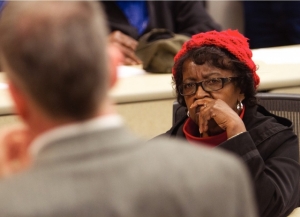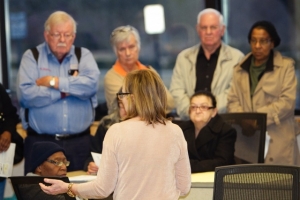Hurricane survivors seek answers about what's next
By Steve Herring
Published in News on March 17, 2017 9:07 AM

News-Argus/STEVE HERRING
Margaret Williams, right, listens as Chris Crew of N.C. Emergency Management answers questions during a Thursday night meeting about the state's Resilient Redevelopment Planning program.

News-Argus/STEVE HERRING
Cindy Camacho, foreground, a consultant with AECOM, talks to the more-than-30 people Thursday night who wanted more information about the housing portion of the state and federal governments' disaster relief programs. They were among the more than 50 to attend a meeting at Wayne Community College to learn more about state's Resilient Redevelopment Planning program.
Flooding from Hurricane Matthew destroyed the heating and air conditioning unit and all of the ductwork under Margaret Williams' Bunche Street home.
Insurance helped some, but she is currently trying to get assistance from the Federal Emergency Management Agency.
Thursday night, Mrs. Williams was among the more-than-30 people bunched around officials as they explaining a new state disaster relief initiative.
Residents peppered the officials with questions about disaster relief funding, timetables for buyouts, elevating their homes, flood insurance and housing concerns as the Federal Emergency Management Agency winds down the program providing funding to house displaced families.
The officials listened and answered the questions.
However, the meeting was not about quick fixes or taking applications for assistance.
Rather its purpose was to introduce the community to the Resilient Redevelopment Planning program and to get residents' input on damages from the hurricane and what is necessary to rebuild.
More than 50 people attended the meeting co-hosted by Wayne County and N.C. Emergency Management held at Wayne Community College. It was conducted by AECOM, a global infrastructure firm, that has been contracted to manage the process for N.C. Emergency Management.
"Following this disaster the state legislature authorized the Disaster Recovery Act of 2016," said Chris Crew of N.C. Emergency Management. "That included some funding to go into the 50 most-impacted counties, and to try to come up with what we are referring to as resilient development plans. The real purpose of this activity is to take a look at all of the traditional funding sources we have with our FEMA partners, other state programs, other federal programs, and see which of our needs that we can cover with these programs, and then see what has fallen through the cracks.
"Once we have looked through all of these sources and tried to match up needs we are fairly confident there are going to be some unmet needs. Our agency has been charged with going back to the legislature at the first of May and try to put a number on that unmet need so we can see if we need to design some new or different programs or provide additional funding to try and meet some of those needs.''
Crew and AECOM's Christine Graziano said they could not comment on the turnout, what was learned or if the meeting had accomplished its goals. But during her opening remarks, Ms. Graziano said it was a good turnout.
The company has been assigned to the 25 most-impacted counties which includes Wayne County, she said.
"Really, we are here to hear what the needs are," she said. "So what is a resilient redevelopment plan? We are identifying unmet needs, identifying projects. The goal is really to come up with a list of projects in four areas and provide a roadmap for community rebuilding.
"We want to make sure we have all of the storm damages accounted for. We want to discuss any ongoing issues that you are experiencing and brainstorm potential projects as we go forward."
The four areas are housing, economic development, infrastructure and environment.
For example for housing some of the issues could include residential flooding, the need to elevate or relocate and finding places for relocations, she said.
"We also want to think about the types of housing that might be needed," she said. "We don't just want to think about replacing what was here, but also creating new options for the future."
As for economic development, the study would look at the storm's impact on businesses and how more jobs can be brought to the community, she said. Another focus could be looking at strengthening utilities so companies can have the resources they need, Ms. Graziano said.
"Infrastructure is all of the things that we need that makes the county work," she said. "Damage might still exist in culverts and drainage -- critical infrastructure like wastewater treatment plants."
The idea is to make them more resilient than they have been in the past, she said.
"Environment, we want to look at damage to recreational resources, wetlands, erosion, drainage issues," she said. "We want to find ways to protect natural resources going forward as well as providing new recreational opportunities forward."
Mrs. Williams she had not known what to expect.
"But I thought well, if I go and it will be a meeting that will help me, but if it doesn't, I will still learn something. I am back at home. There was minimum damage inside the house. I had homeowner's insurance, but by the time they did the deductible it was me still having to pay."
Mrs. Williams said she had learned a lot at the meeting about housing and that it was worth attending.
The effort, and resulting resilient redevelopment plans, will be the foundation for any supplemental funding received through Congress, the North Carolina General Assembly and other funding sources.
The plans will also provide the foundation for the state's Recovery Action Plan that is required by the U.S. Department of Housing and Urban Development before the state can expend the funding received from the Community Development Block Grant -- Disaster Relief program.
Two additional meetings on the program are planned. The dates, times and locations have not yet been announced.
The next meeting will deal with construction, review and feedback on the first drafts of resilient strategies. The third will focus on the refinement, feedback and finalization of the strategies.
The plan will be delivered to the General Assembly by May 1.
For more information, contact Bel Marquez at 919-415-2729 or [email protected]. Ms. Graziano, who is the lead AECOM planner for the county, can be reached at 703-682-9133 or [email protected].
